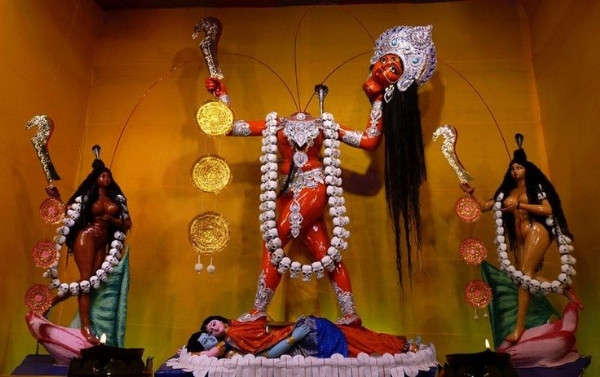Chhinnamasta - Transformative contradictions
25 Oct 2023 16:08:25
Goddesses are always seen as the universal mother and caregiver in the entire world, but Hindu faith is the only faith where goddesses can also be seen as Mother and destroyer both; because Bharat is the land where contradictions are celebrated.

The Chhinnamasta, is the goddess of transformation as well as contradictions. She is the incarnation of goddess which illustrates the both sides of goddess- Life giver and life-taker. She is seen as a symbol of self-control over desire and the embodiment of fundamental energy, in whichever way you are seeing her.
She is the representation of death, temporality and destruction along with life, immorality and recreation.
In the Shaktism, there are two kulas- Srikula and Kalikula, as Tripura Sundari was worshiped in the Srilula- Chhinnamasta is worshiped in Kalikula, she is the one of the Mahavidyas, the temples of Chhinnamasta are only found in Nepal and Eastern India, but her public worship is not popular.
Goddess is the incarnation of spiritual self-actualization and the awakening of the Kundalini- Spiritual and Divine energy resides in our body. The stories of Chhinnamasta emphasize her self-sacrifice – sometimes coupled with a maternal element, along with physical dominance, and self-destructive fury.
As she is the incarnation of carnal energy, she is the dominant Tantric deity. She is also known as Chhinnamastika or Prachanda Chandika.
In the depictions, Chinnamasta is always shown as holding her own head, which was bloody because she just cut it off. Due to the self- decapitation of the goddess, she is also called as “Prachanda Chandika”. She is the ferocious power of nature. Chinnamasta actually means, “severed head”, and in Hindu beliefs, she is often correlated with fearsome nature.
She wears a serpent and garland of skulls, blood is pouring from her neck as she severs it, she is being attended by her two female attendants- Dakini and Varini.
She carries her own head in her left hand, as per ancient records, she is only 16 years old, with full-breast and blue lotus near her heart.
In the temples and idols, she is mostly nude with unkempt hair and blood smearing her body. She stands over a naked couple, who are said to be Kama Deva and Rati. Rati – the Goddess of sexual desire – and her husband the Kama – the God of love.
Chhinnamasta is closely related to Chinnamunda – the severed-headed form of the Tibetan Buddhist goddess Vajrayogini.
The prime story of Chinnamasta is Parvati was bathing in the Mandakini river, she was aroused, because of that arousal, she turned black. At the same time, her two attendants Dakini and Varnini got hungry, and asked their mother, Parvati, to feed them. Now, there was no food in sight, Parvati cut her head and blood started to flow in three directions, two in her attendant's mouth and one in her mouth. This is Parvati’s incarnation of Goddess Chhinnamasta.
Chhinamasta is a symbol of Life, Death and Physical intimacy; the three expressions of Transformation and the three parts of every life cycle. Her standing over the couple can mean the victory of self-control over worldly desires, and the end of the cycle of samsara- the cycle of birth, death and rebirth.
The presence of Rati in Kama in Chhinnamasta depictions are actually a symbol of her self control and ability to deplete any desire. Some representations of the goddess show her sitting on top of Shiva in the act of sexual intercourse, lending further credibility to her association with desire, and the practices of kundalini yoga.
Chinnamasta is the goddess of contraction as well as transformation. She teaches us to learn the truth behind every worldly thing. She is the primal and igniting force of nature, which lives in everyone.
In Spite of this carnal energy, she is the one with motherly love. She is the one who nourishes the entire world with her own blood, she is the one who shows us the true meaning of life….!!!
--